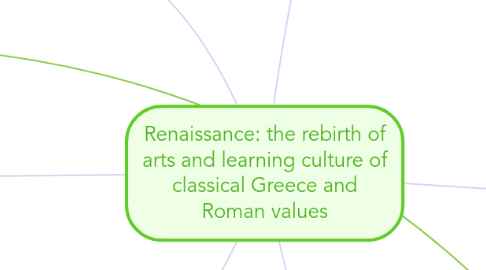
1. Main Values and Ideas promoted
1.1. Christian humanists’ attempts to reform society changed views about how life should be lived.
1.2. People began to question political structures and religious practices. Renaissance ideas continued to influence European thought.
1.3. Individual achievement became important during the Renaissance
1.4. ‘’All educated people were expected to create art."
1.5. Anthropocentrism, the idea that humans should be at the center of everything (the main focus).
2. Artistic Styles and Forms promoted
2.1. Presence of classical art, perspective, religion, importance of the individual, and use of many details to add beauty
2.2. Art drew on techniques and styles of classical Greece and Rome.
2.3. Paintings and sculptures portrayed individuals and nature in more realistic and lifelike ways.
2.4. Artists created works that were secular as well as those that were religious.
2.5. Writers began to use vernacular languages to express their ideas.
2.6. The arts praised individual achievement.
2.7. Renaissance writers wrote either for self-expression or to portray the individuality of their subjects- writers of the Renaissance began trends that modern writers still follow.
3. Major Renaissance Artists and Writers
3.1. Francesco Petrarch was one of the most influential humanists (known as the father of the Renaissance humanism).
3.2. Boccaccio, an Italian writer. Famous for his book Decameron.
3.3. Artemisia Gentileschi painted pictures of strong, heroic women.
3.4. Raphael Sanzio was famous for his use of perspective
3.5. Leonardo da Vinci: painter, sculptor inventor and scientist (known as a true Renaissance Man).
3.6. Michelangelo Buonarroti: also known as a Renaissance Man, famous for his portrayal of the human body both in painting and in sculptures. He was a painter, sculptor, architect, and poet.
4. Merchants dominated politics (did not inherit in social rank). As a result, many merchants believed they deserved power and wealth.
5. Influenced classical art
6. Causes of the Renaissance
6.1. Italian Renaissance
6.1.1. Merchants dominated politics (they did not inherit in social rank). As a result, many merchants believed they deserved power and wealth.
6.1.1.1. Individual achievement became important during the Renaissance
6.1.2. Florence became under the rule of the banking family the Medici, a wealthy influenced people of the ruling council.
6.1.3. Three advantages that made Italy the birthplace of the Renaissance: thriving cities, a wealthy merchant class, and the classical heritage of Greece and Rome.
6.1.3.1. Growth of large city states was led by overseas trade (consequence of the Crusades).
6.1.3.2. Scholars from Constantinople fled to Rome with Greek manuscripts when the Turks conquered Constantinople in 1453.
6.2. Northern Renaissance
6.2.1. 1450 the population of northern Europe-had declined due to bubonic plague-beginning to grow again
6.2.2. When the destructive Hundred Years’ War between France and England ended-many cities grew rapidly-Urban merchants became wealthy enough to sponsor artists.
6.2.3. England and France were unified under strong monarchs. These rulers sponsored the arts by purchasing paintings and by supporting artists and writers.
6.2.3.1. For example: Francis I of France invited Leonardo da Vinci to retire in France, and hired Italian artists and architects to rebuild and decorate his castle at Fontainebleau
6.2.4. The Renaissance ideal of human dignity inspired some northern humanists to develop plans for social reform based on Judeo-Christian values. Southern Italy and launched an invasion through northern Italy. Many Italian artists and writers left for a safer life in Northern Europe. They brought with them the styles and techniques of the Italian Renaissance.
